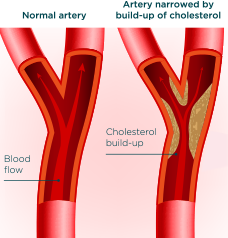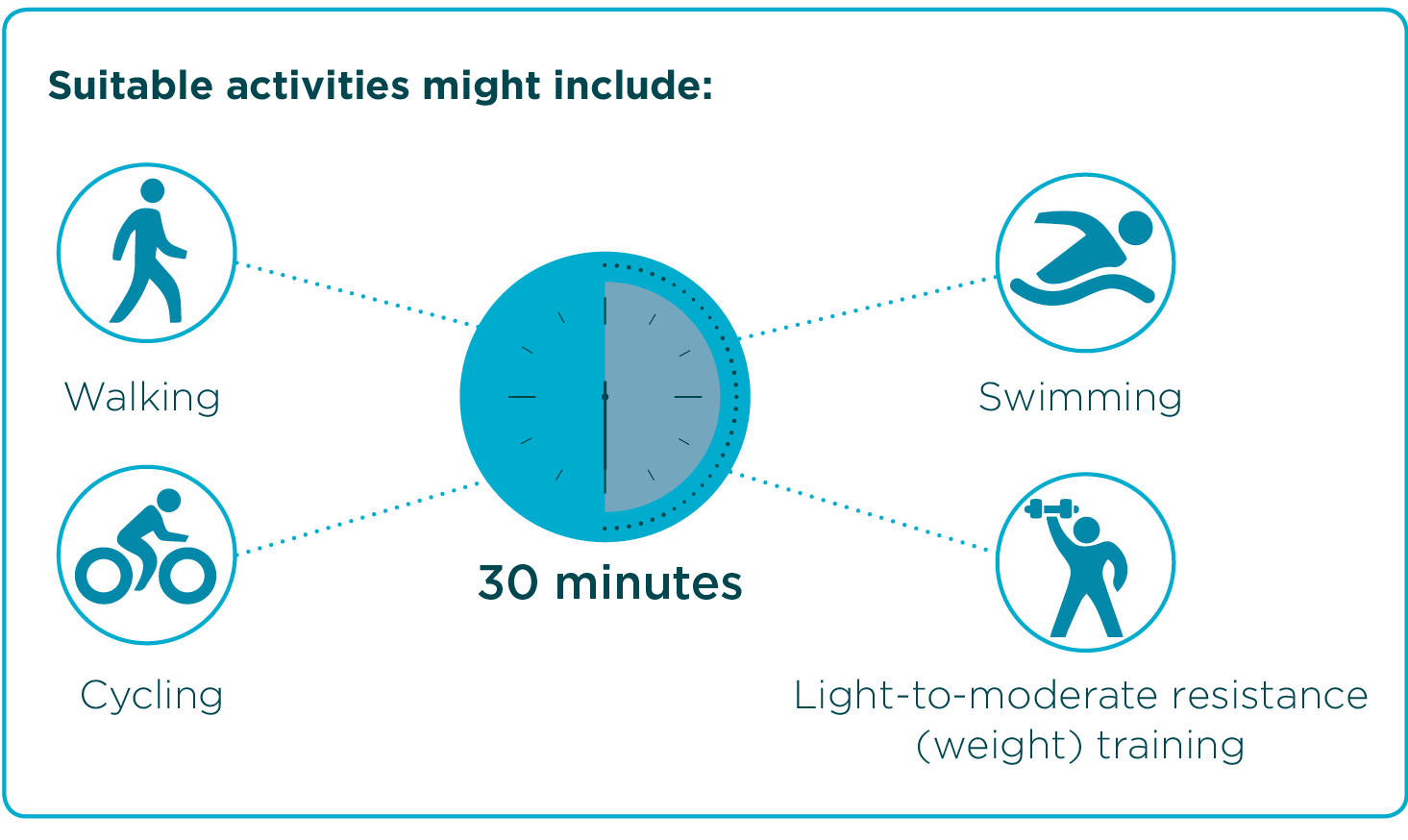Maintaining a healthy cholesterol level is not just about taking medication; it also requires you to be active in maintaining a healthy lifestyle. Learn more here about the lifestyle steps you can take to help reduce your ‘bad’ cholesterol levels.
FAQs about high cholesterol
- What you eat: Eating foods high in saturated fats and trans fats (see Can changing what I eat lower my cholesterol?) increases your levels of ‘bad’ cholesterol.
- What you weigh: Being overweight increases your risk of heart disease.
- How active you are: Having an inactive lifestyle with no regular exercise is a risk factor for heart disease.
- Whether you’re a smoker: Smoking increases your risk of heart disease.
- Your genes and family history: Some people have an inherited condition (called familial hypercholesterolaemia, or FH for short) that makes them more likely to have high levels of ‘bad’ cholesterol.
- Your age: Your risk of heart disease naturally increases with age.
- Margarine spreads made from vegetable oils (instead of butter)
- Vegetable oils (e.g. sunflower, soybean and safflower oils)
- Oily fish (e.g. salmon)
- Margarine spreads
- Olive, canola or peanut oil
- Avocados
- Some nuts
- Reduced-fat dairy products
- Lean cuts of meat (fat or skin removed)
- Vegetables (5 serves/day) and fruit (2 serves/day)
- Wholegrain bread, cereal, pasta, rice, noodles
- Up to 2 eggs/day
- Fatty meats
- Full-fat dairy products
- Butter
- Some oils (e.g. coconut and palm oil)
- Many takeaway foods (e.g. pies, pizza, fish and chips, hamburgers, creamy pasta)
- Many baked products (e.g. biscuits, pastries, pies)
- Deep-fried foods and takeaway foods
- Baked products (e.g. biscuits, pastries, pies)
- Processed meats (e.g. sausages, ham, salami)
- Salty, sugary or fatty snack foods (e.g. potato crisps, biscuits, lollies, chocolates)
- Can increase triglyceride levels
There are different types of cholesterol, including:
 ‘Bad’ cholesterol, also called low density lipoprotein cholesterol (LDL-C):
‘Bad’ cholesterol, also called low density lipoprotein cholesterol (LDL-C):
is the main source of cholesterol that can build up and block your arteries.
 ‘Good’ cholesterol, also called high density lipoprotein cholesterol (HDL-C):
‘Good’ cholesterol, also called high density lipoprotein cholesterol (HDL-C):
helps to keep cholesterol from building up in your arteries.
You should aim for low levels of ‘bad’ cholesterol to reduce your risk of
developing heart disease.
Over time, 'bad' cholesterol can build up inside the walls of your arteries and can gradually clog them up.
This narrowing of the arteries slows down or blocks the flow of blood to the heart. High levels of ‘bad’ cholesterol can increase the risk of heart attacks and strokes.

Typically, people with high ‘bad’ cholesterol don’t have any obvious symptoms. You may feel well and only find out you have the condition after a blood test to check your cholesterol levels.
A number of possible factors can cause ‘bad’ cholesterol levels and increase your risk of heart disease.
You can take steps to lower your ‘bad’ cholesterol by:
 Eating healthy foods and watching your weight (see Can changing what I eat lower my cholesterol?)
Eating healthy foods and watching your weight (see Can changing what I eat lower my cholesterol?)
 Increasing the amount of exercise you do (see Can exercising lower my cholesterol?)
Increasing the amount of exercise you do (see Can exercising lower my cholesterol?)
 Taking cholesterol-lowering medicines prescribed by your doctor (along with making healthy lifestyle changes).
Taking cholesterol-lowering medicines prescribed by your doctor (along with making healthy lifestyle changes).
 You can also reduce your risk of heart disease by quitting smoking (see Would quitting smoking decrease my chances of heart disease?)
You can also reduce your risk of heart disease by quitting smoking (see Would quitting smoking decrease my chances of heart disease?)
The food you eat has an effect on your cholesterol levels, particularly the type of fats you eat. So, it makes sense that changing what you eat can help lower your ‘bad’ cholesterol and your risk of heart disease.
In general, you should try to reduce the amount of saturated fats and trans fats you eat and replace them with healthier polyunsaturated fats and monounsaturated fats.
Healthy eating means including a variety of healthy food choices most of the time, but recognising that an occasional treat is okay.
For more information about healthy eating, visit www.heartfoundation.org.au
Eat foods that contain 'healthy' fats
Polyunsaturated fats:
Monounsaturated fats:
Limit foods that contain 'unhealthy' fats
Saturated fats:
Trans fats:
Alcohol:
Being physically active not only improves your fitness but can also reduce your LDL or ‘bad’ cholesterol levels, lower your risk of heart disease, and help you manage your weight.
It doesn’t have to be strenuous exercise for you to get benefits, even brisk walking is good for your health.
Aim for 30 mins of moderate-intensity exercise on most (or all) days of the week. (If necessary, you can break it up into 3 x 10-minute sessions).
For more information about how to add more physical activity to your life or for low-intensity exercise tips especially designed for people with heart conditions, including heart disease, visit www.heartfoundation.org.au/active-living/get-active.
Remember, always speak to your doctor before you start any exercise program or change the amount of exercise you currently do.

Although lifestyle changes can make a difference, they may not lower LDL or ‘bad’ cholesterol enough in some people, so cholesterol-lowering medicines may be needed. One group of drugs called statins are often used to bring down LDL or ‘bad’ cholesterol levels.
However, sometimes statins on their own may not be enough to get LDL cholesterol down to healthy levels. Some people may also not be able to take statins because of side effects.
Your doctor has prescribed Praluent to help you reach your LDL cholesterol goal. Speak to your doctor to learn what your LDL cholesterol target is.
Praluent works in a different way to statins and can be used with other medicines (including statins) to lower your ‘bad’ cholesterol.
Yes. Smoking increases the risk of heart disease, including heart attack and stroke. So quitting is an important step towards protecting your health.
Tips to help you quit
 1. Make a plan.
1. Make a plan.
Set a date to quit and plan how to deal with the triggers that make you want to smoke
(e.g. stress, eating, drinking).
 2. Talk to your doctor or pharmacist about your options
2. Talk to your doctor or pharmacist about your options
(e.g. nicotine replacement products or medicines to help you quit)
 3. Call Quitline (13 78 48)
3. Call Quitline (13 78 48)
for information and support.
Remember, if you start smoking again, you haven’t failed. Learn from the experience and try again.
Why have I been prescribed Praluent?
Your doctor has prescribed Praluent because your other medicines either didn’t lower your LDL cholesterol enough on their own, or they caused side effects.
Talk to your doctor if you have any questions about why you have been prescribed Praluent


